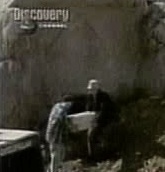
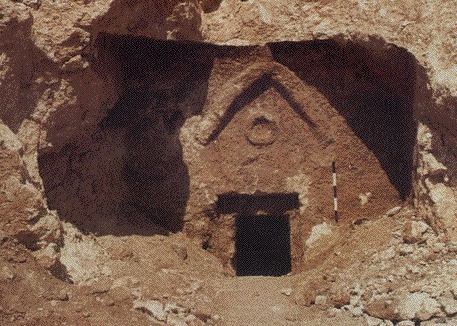
The tomb in Talpiot of Madonna Mary may have contained 10 ossuaries:


The tomb in Talpiot of Madonna Mary may have contained 10 ossuaries:
If so,
Mary would have been buried with all her sons and one daughter (perhaps the other daughter was married and buried with her husband and children), all of whom may have died in the area of Jerusalem. Matthew, Mary Magdalene, and Judah may have died in Ethiopia, with their bodies being brought to Jerusalem to be buried with Jesus and his mother. Judah may have had children who remained in Ethiopia and were buried there.
According to a 25 February 2007 discovery.com news article from which the above image was taken: "... New scientific evidence, including DNA analysis ... suggests a 2,000-year-old Jerusalem tomb could have once held the remains of Jesus of Nazareth and his family. The findings also suggest that Jesus and Mary Magdalene might have produced a son named Judah. ...[ according to a wikipedia article: "... Both Mark and Matthew describe Jesus as having brothers ...
According to the book "The Jesus Family Tomb" ( HarperCollins 2007) by Simcha Jacobovici and Charles Pellegrino with foreword by James Cameron: ".... Only three ossuaries in the tomb were decorated. The nameless 80/508, the Mariamene ossuary ... and the ossuary seeming to belong to her son, Judas. ...". Six] of the 10 discovered boxes in the Talpiot tomb were inscribed with names believed to be associated with key figures in the New Testament:
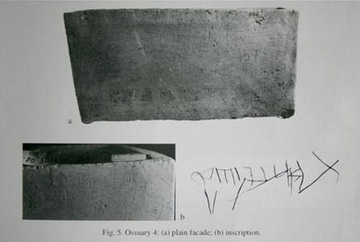
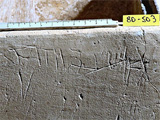 ]...
]...
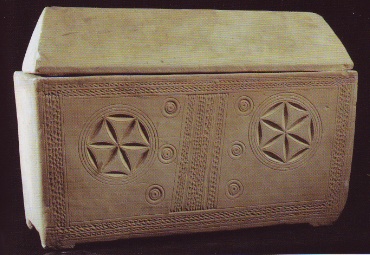
Note the two Flowers of Aphrodite and two sets of 3 circles. According to "The Woman's Dictionary of Symbols and Sacred Objects by Barbara G. Walker (HarperCollins 1988): "... The Flower of Aphrodite is composed of six vesicas [ joined at the center - on the ossuary, six more are the edges of each surrounding hexagon ] ... synonym[s] for the yoni, or vulva. ... the feminine creative force ... The ancients insisted that women's sexual secretions smelled like fish, which is why the sign ... came to be called vesia piscis ... in her Love-goddess aspect, the Ancient Mother was associated with fish, seashells, seawater ... Six was the sexual number especially sacred to the Goddess Aphrodite; Pythagoreans called six the perfect number, or The Mother. ...". According to "The Woman's Encyclopedia of Myths and Secrets by Barbara G. Walker (HarperCollins 1988): "... Aphrodite ... Like Kali ... was a Virgin-Mother -Crone trinity [ hence the sets of 3 circles - if the 6+6 = 12 vesicas of each set of the ossuary are multiplied by the 3 of the circles, and the total number of vesicas is summed, the result is 12x3 + 12x3 = 72 vesicas, the Islamic heavenly number ] ... She was ... indistinguishable from the Fates (Moira) ... She was also called Mari, the Sea. ..."]...
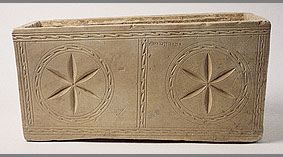
... Israel Antiquities Authority, 80-501 Photo: The Israel Museum, Jerusalem / by Avraham Hay ...". Note the two Flowers of Aphrodite, simpler than those on the ossuary of his mother Mary Madgalene. ... According to "The Woman's Encyclopedia of Myths and Secrets by Barbara G. Walker (HarperCollins 1988): "... Aeneas ... Son of Aphrodite founder of Rome ... saved the sacred Palladium from the sack of Troy, and carried it to the site of Rome, where it was installed in the temple of Vesta. ... Palladium ... was said to embody the essential spirit of Rome, as it had previously emobodied the spirit of Troy. ... It was a symbol of a protean, androgynous deity usually called Pallas, whose name meant either "maiden" or "youth" .... Constantine moved the Palladium to Constantinople and made it a symbol of his own masculinity. ...". Compare Sheba saving the Ark of the Covenant by taking it to Ethiopia. ]...
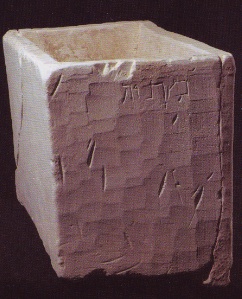
is the only one plain enough to compete with the Jesus ossuary for the title of "most ordinary" ... Acording to a wikipedia article on Matthew: "... Matthew the Evangelist ... is ... one of Jesus' Twelve Apostles ... believed to be the author of the Gospel of Matthew ... He is one of the few disciples mentioned by name in the apocryphal Gospel of Thomas, suggesting he was of more importance in the early church than surviving evidence indicates. Legend has it that he preached the gospel for a long time after the ascension and carried it all the way to Ethiopia where he was killed ...". ]...
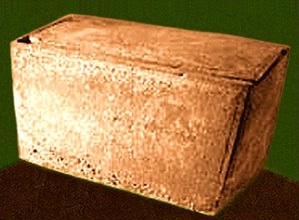
... is a plain and very common limestone type of bone box, but ... its inscription is unusually refined ... ". According to a 7 April 2006 ABC news article: "... James Tabor is the chairman of religious studies at the University of North Carolina at Charlotte. His book ... 'The Jesus Dynasty' ...[says:]"... on ... October 21, 2002, ... Hershel Shanks, editor of Biblical Archaeology Review, announced at a press conference ... that a limestone ossuary or "bone box" inscribed in ancient Aramaic with the phrase "James son of Joseph brother of Jesus" had surfaced in Jerusalem. ... Oded Golan, had bought the ossuary fifteen years earlier from a Jerusalem antiquities dealer who said it came from the area of Silwan, just south of the Old City of Jerusalem. ... this particular ossuary had not come from any authorized archaeological excavation ...[ Why did grave robbers chose it to steal? Maybe it migth hav ebeen the easiest to get out, and maybe at least in part because of its refined inscription. ]... modern cuts into ancient limestone will not contain the ancient patina that naturally coats the surface of the stone over time. ... the patina inside the letters was ancient, adhering firmly to the stone ... a special exhibit for the ossuary at the Royal Ontario Museum in Toronto ... would open in late November 2002 ... When the ossuary suddenly made world headlines ... the Israeli authorities were taken completely unawares and were duly embarrassed. ... The Israelis immediately initiated an investigation into the circumstances of Golan's acquisition of the ossuary ... According to Israeli law, if Golan had acquired it after 1978, the ossuary would have been sold illegally and subject to confiscation by the state ... When the ossuary arrived in Toronto it had been cracked in transit and the scientific team at the Royal Ontario Museum took on the task of repairing it for the exhibit. One of the cracks ran through part of the inscription, allowing the scientific team at the museum to more closely examine the way the letters were cut into the limestone. They agreed with the Israeli scientists that ancient patina was present in the letters, it was firmly adhering to the stone and consistent with the rest of the ossuary. ... When the James Ossuary was returned to Israel in February 2003, the Israel Antiquities Authority confiscated it ... In June 2003 the IAA committee declared the ossuary genuine but the inscription a partial forgery. ... Golan was ... formally indicted and charged with adding the phrase "brother of Jesus" to an otherwise genuine ossuary that was inscribed with "James son of Joseph," attempting to coat the letters with a fake baked-on patina, and lying about when he acquired the ossuary ... one member of the IAA committee who, against his better judgment, went along with the original vote now says he thinks the inscription is authentic. ... One member of the IAA committee has said that she saw ancient patina in the last two letters of the inscription -- the very part that is supposed to be forged. The geologists from the Geological Survey of Israel who initially found the inscription to be authentic have not changed their position, nor has the scientific team at the Royal Ontario Museum that examined the ossuary after it was broken. ..." ...". ]...
... Jacobovici, director, producer and writer of "The Lost Tomb of Jesus," and his team obtained two sets of samples from the ossuaries for DNA and chemical analysis.
According to a 7 April 2006 ABC news article: "... James Tabor is the chairman of religious studies at the University of North Carolina at Charlotte. His book ... 'The Jesus Dynasty' ... maintain[s]that Jesus is ... most likely the child of a Roman soldier named Pantera. Jesus, Tabor maintains, became the head of the household when Joseph died and looked after his six half-brothers and sisters. When Jesus died, his brother James took over his dynasty. Jesus and James' teachings, Tabor says, are very different from the Christian philosophy that eventually spread across the world. ... excerpt[s] of the book ...[say:]...
of the thousand or more ossuaries stored and catalogued in various Israeli collections, six bore the name "Jesus" (Yeshu, Yeshua, or Yehoshua in Hebrew), and of those six, two were inscribed with the designation "Jesus son of Joseph." ...
Jesus had been placed hastily in a tomb near the crucifixion site by an aristocratic and influential sympathizer, Joseph of Arimathea, and not in his own family tomb. Even the gospels imply that he was only temporarily put there, due to the rush of the Passover holiday. Although the family was from Nazareth, a town to the north in Galilee, the New Testament indicates that Mary as well as Jesus' brothers and sisters had taken up residence in Jerusalem. Tradition has it that Mary, mother of Jesus, did in fact die and was buried in Jerusalem ...
three skulls ... were ... placed curiously on the floor of the tomb, each directly in front of a loculus or shaft holding ossuaries. ...
Also ... The front of the tomb had a strange decoration carved into the facade over the entrance -- a circle with ...[ a chevron ]... over it. ...".
The /\ chevron might represent a blade, or male symbol, and the o circle might represent a cup, or female symbol. Together, they might represent an eyebrow over an eye ( like a simply styled Eye of Horus ).
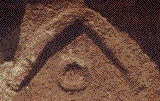
According to "The Woman's Encyclopedia of Myths and Secrets by Barbara G. Walker (HarperCollins 1988): "... The All-Seeing Eye of Ancient Egypt once belonged to the Goddess of truth and judgment, Maat. ... A late text tranferred the All-Seeing Eye to a male god, Horus. ... In Syria ... "Eye Goddess" ... was known as the Goddess Mari, whose huge eyes searched men's souls. ...".